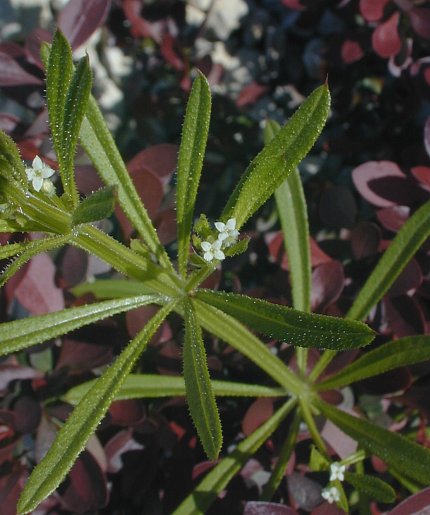Description: This plant is a winter or spring annual about 1-3' long that is either unbranched or sparingly branched. It has weak stems with whorls of 6-8 leaves; these whorls of leaves are rather widely separated from each other. Both the stems and leaves have stiff hairs that point downward; this enables the plant to cling to adjacent vegetation for support. The stems are 4-angled and furrowed. The leaves are up to 3" long and ¼" across; they are linear-oblong or linear-oblanceolate, entire (toothless) and ciliate (with stiff hairs) along their margins, and sessile. Each leaf has a single central vein along its length. From the middle to upper whorls of leaves, either solitary flowers or small cymes of 2-3 flowers are produced on short peduncles. Sometimes compound cymes are produced, although the total number of flowers remains small. At the base of the peduncle of each cyme, there are 1-4 secondary leaves (or leafy bracts); they are smaller than the whorled leaves of the stems. Each flower is about 1/8" (3 mm.) across. It consists of 4 white petals with pointed tips, 4 stamens, 2 styles, and a pair of green carpels that are joined together at the base of the flower. The sepals are tiny and insignificant. The paired carpels are covered with stiff hooked hairs, providing them with a bur-like appearance. Together, the carpels are about ¼" across when they are fully developed. The blooming period occurs from late spring to mid-summer and lasts about 1-2 months. After the petals fall off, the carpels eventually turn brown. Each carpel contains a single greyish brown seed that is notched on one side. The root system is branching, fibrous, and shallow. This plant spreads by reseeding itself.

Cultivation:
The
preference is partial sun to light shade, moist conditions, and a rich
loamy soil with higher than average nitrogen content. The seeds usually
germinate during early spring; most vegetative growth occurs during
mid- to late spring. Full sun is tolerated if there is sufficient
moisture.
Range & Habitat:
Cleavers is a common plant that occurs in every county of Illinois (see
Distribution
Map).
This species has a circumboreal distribution and it
is native to both North America and Eurasia, including Illinois.
Habitats include
woodlands, thickets, seeps, limestone glades, weedy meadows in
floodplain areas, fence rows, barnyards, ditches, flower beds, and
edges of dumps. This species occurs in both natural and disturbed
habitats.
Faunal Associations:
The flowers attract few insects; small bees and flower flies visit them
occasionally. The caterpillars of several moths feed on the flowers or
foliage,
including Lobocleta ossularia (Drab Brown Wave), Pleuroprucha
insulsaria (Common Tan Wave), and Scopula
limboundata
(Large Lace Border). Canada Geese will eat the foliage of plants near
bodies of water. The burs cling readily to the feathers of birds, fur
of mammals, and the clothing of humans; this assists in the
distribution of the seeds to new locations.

Photographic
Location:
Near some shrubbery at the webmaster's apartment in Urbana, Illinois.
Comments:
Cleavers is the most common Galium sp. (Bedstraw)
in Illinois. Other common names for Galium aparine
include Goosegrass and Annual Bedstraw. It is a rather weedy plant with
insignificant flowers. Cleavers has up to 8 leaves per whorl, while
other Bedstraws usually have only 4 or 6 leaves per whorl. The carpels,
leaves, and stems of Cleavers have an abundance of stiff hairs that can
cling readily to clothing, fur, or adjacent vegetation; this
distinguishes it from about one-half of the other Bedstraws, which have
smooth to slightly rough carpels and foliage. Another species with
white flowers, Galium mollugo (Hedge Bedstraw), has
whorls of 6-8 leaves like Cleavers. However, Hedge Bedstraw has smooth
carpels and foliage and it produces a large terminal inflorescence with
an abundance of flowers. In the past, various Bedstraws were used to
curdle milk in the production of cheese because their roots are
somewhat acidic.